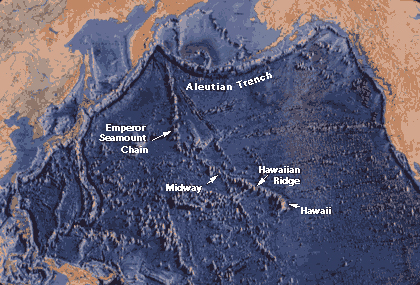Geotimes

Web
Extra Monday,
August 11
The Hawaiian hotspot debate:
an update
 The line of
volcanic isles, known as the Hawaiian Ridge, intersects a line of older volcanoes
called the Emperor Seamounts. At this intersection, called the Hawaiian Emperor
Bend, these two ridgelines go abruptly in differing directions. Either the Pacific
plate or the hotspot had to shift in order to build the new line of isles.
The line of
volcanic isles, known as the Hawaiian Ridge, intersects a line of older volcanoes
called the Emperor Seamounts. At this intersection, called the Hawaiian Emperor
Bend, these two ridgelines go abruptly in differing directions. Either the Pacific
plate or the hotspot had to shift in order to build the new line of isles.
Most geologists have long thought that the Hawaiian Islands formed by the Pacific
plate moving over a hotspot plume that sat fixed in the mantle; however, recent
research suggests a moving hotspot could have been responsible.
In the July 24 online Science, geophysicist John Tarduno at the University
of Rochester and colleagues theorize that earth's hotspots can move, and that
southern motion of the Hawaiian hotspot, not northern motion of the Pacific
plate, formed the Emperor Seamounts.
Part of the Pacific Basin
showing the volcanic trail of the Hawaiian Ridge-Emperor Seamounts chain. Courtesy
of USGS.
Tarduno's findings, which Geotimes first reported on in
March, could change the entire model of plate tectonics-from
how plates move to how land masses form. The paper's recent publication has
stirred a new round of debate.
 Geophysicist Pål
Wessel of the University of Hawaii at Manoa and colleagues have written a paper
to submit to Nature that refutes many of Tarduno's findings. Wessel has
been working on a new motion model of the Pacific plate movements based on a
fixed hotspot hypothesis. For Tarduno's theory of a moving hotspot to be correct,
the hotspot plumes beneath the Pacific would have to be moving collectively.
Wessel says that's not likely but is yet unproven.
Geophysicist Pål
Wessel of the University of Hawaii at Manoa and colleagues have written a paper
to submit to Nature that refutes many of Tarduno's findings. Wessel has
been working on a new motion model of the Pacific plate movements based on a
fixed hotspot hypothesis. For Tarduno's theory of a moving hotspot to be correct,
the hotspot plumes beneath the Pacific would have to be moving collectively.
Wessel says that's not likely but is yet unproven.
Tarduno's research is based on paleomagnetic and radiometric age data from
lava samples collected during an ocean drilling project. Magnetic minerals within
the lava at the Hawaiian Ridge and the Emperor seamounts do not align. If the
hotspot had been stationary, the minerals would have corresponded, Tarduno writes.
Artist's conception of the movement
of the Pacific Plate over the fixed Hawaiian hotspot, illustrating the formation
of the Hawaiian Ridge-Emperor Seamount Chain. Courtesy of USGS.
Although Wessel does not refute Tarduno's data findings, he
does disagree with the conclusions. He and others believe there are better explanations,
such as true polar wander (Geotimes, March 2003).
"It's an important dilemma that has yet to be resolved. We need more paleomagnetic
and radiometric age data from other chains before we can figure out the motion
model of the Pacific plate," Wessel says.
For now, scientists will continue their research to decode the naissance of
the Hawaiian Islands.
Megan Sever
Links:
Bending
thoughts about the Hawaiian chain, Geotimes,
March 2003
ScienceExpress
USGS
Hawaiian Hotspot Information
Back to top
 Geophysicist Pål
Wessel of the University of Hawaii at Manoa and colleagues have written a paper
to submit to Nature that refutes many of Tarduno's findings. Wessel has
been working on a new motion model of the Pacific plate movements based on a
fixed hotspot hypothesis. For Tarduno's theory of a moving hotspot to be correct,
the hotspot plumes beneath the Pacific would have to be moving collectively.
Wessel says that's not likely but is yet unproven.
Geophysicist Pål
Wessel of the University of Hawaii at Manoa and colleagues have written a paper
to submit to Nature that refutes many of Tarduno's findings. Wessel has
been working on a new motion model of the Pacific plate movements based on a
fixed hotspot hypothesis. For Tarduno's theory of a moving hotspot to be correct,
the hotspot plumes beneath the Pacific would have to be moving collectively.
Wessel says that's not likely but is yet unproven. 
 The line of
volcanic isles, known as the Hawaiian Ridge, intersects a line of older volcanoes
called the Emperor Seamounts. At this intersection, called the Hawaiian Emperor
Bend, these two ridgelines go abruptly in differing directions. Either the Pacific
plate or the hotspot had to shift in order to build the new line of isles.
The line of
volcanic isles, known as the Hawaiian Ridge, intersects a line of older volcanoes
called the Emperor Seamounts. At this intersection, called the Hawaiian Emperor
Bend, these two ridgelines go abruptly in differing directions. Either the Pacific
plate or the hotspot had to shift in order to build the new line of isles.
